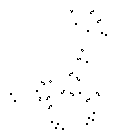
The existence of this stable reflector meant not only that oscillators of all sufficiently large periods exist (which had already been proved by Dave Buckingham), but also that they need only have a few hundred live cells.
Another point to note about the above reflector is that the last two blocks are merely used to delete the Herschel after it has fired its glider. Removing these two blocks, and suppressing the unwanted output gliders, gives a stable glider-to-Herschel converter (shown below). Glider-to-Herschel converters can be used for further interesting constructions, as will be shown at the end of this article.
Dean Hickerson soon found a way to modify Callahan's original reflector to make it faster. The Herschel-to-glider mechanism that he used to achieve this turns out to be of use also in a later reflector. Hickerson's modified reflector is shown below. The non-standard still life used here is needed in order to allow the use of the 64 64 77 sequence of Herschel conduits. (In fact a smaller still life will do the job, as will be seen in a moment.)
In this reflector the Herschel is destroyed at the end, so we don't get a new glider-to-Herschel converter. Actually this is not strictly true. An arrangement of reflectors could be used to produce a Herschel by colliding two gliders, thus giving a glider-to-Herschel converter as fast as the reflectors. But this sort of construction is so large (at least with present stable reflectors) that it will be ignored for the remainder of this article.
Dave Buckingham found a faster stable reflector that does not use Paul Callahan's special reaction. Instead, the incoming glider hits a boat to make a B-heptomino, which is converted into a Herschel and moved round to restore the boat. A compact form of the 119-step Herschel conduit is needed here, as is a non-standard still life to cope with the 64 64 77 conduit sequence.
Again the Herschel is destroyed at the end, so no new glider-to-Herschel converter results.
It is a fact of Life that a given R-to-Herschel conduit almost never works with any given source of R-pentominoes. There is a good reason for this. While Herschels are usually produced by a standard evolutionary sequence which throws the Herschel away from its source, R-pentominoes (and most other common active objects) tend to be produced in relatively inaccessible places. I was, therefore, not very hopeful about the usefulness of the new conduit. But it turned out that there was one R-pentomino source with which it could be used: Paul Callahan's reflector reaction. There was therefore the possibility of an improved reflector, especially as the new conduit produced a Herschel that appears sooner and is closer to the beehive that must be deleted.
Putting the relevant data into my Herschel track program produced the following stable reflector with a recovery time of 623. Dean Hickerson's method of producing a forwards glider again proves useful.
At the time of writing this is the fastest and smallest known stable reflector. Nonetheless it is still very slow and very large. Major improvements can only come from methods that do not involve moving a Herschel round to fix some defect created by the glider impact, but all attempts to find such a method have so far failed.
Another track gave the following glider-to-pi converter making use of Paul Callahan's 95-step Herschel-to-pi conduit, which happens to fire a glider in just the right way.
This was nice, but there was no known way of converting the pi-heptomino into a Herschel, so it didn't result in an improved glider-to-Herschel converter. In fact the best I could manage was the following, only slightly faster than Paul's original, and also larger.
But later that same month Paul found a pi-to-Herschel conduit that can be added to his Herschel-to-pi conduit to make a 176-step Herschel conduit. This was just what I needed to produce a much faster glider-to-Herschel converter, also smaller than my last one:
It should perhaps be pointed out that all these reflectors and converters are not quite as bad as their large recovery times make them appear. It is possible, for certain periods, to pack multiple active objects into the reflector/converter with each one deleting the beehive (or, in the case of Dave Buckingham's reflector, replacing the boat) that would normally be dealt with by a later one. As an example of this, here is a p157 gun consisting of two copies of the latest stable reflector:
p157 glider gun using two stable reflectors.
(It can be shown that such a reflector loop can be packed to period k iff (r-1) mod k >= 114, where r is the recovery time. The time around the whole loop must, of course, be a multiple of k --PBC).
The new faster glider-to-Herschel converter naturally led to faster glider-to-spaceship converters. New Herschel conduits and a (relatively) small method of duplicating a Herschel that I had not previously been aware of led to reductions in size as well. Here then are some of the better glider-to-spaceship converters that I have made, one for each of the three basic orthogonal spaceships. In each case the recovery time is 629 because of the glider-to-Herschel stage, the Herschel-to-spaceship stage being much faster (262 in all cases, the bottleneck being the Herschel duplicator).
 Back to Paul's Page of Conway's Life Miscellany
Back to Paul's Page of Conway's Life Miscellany